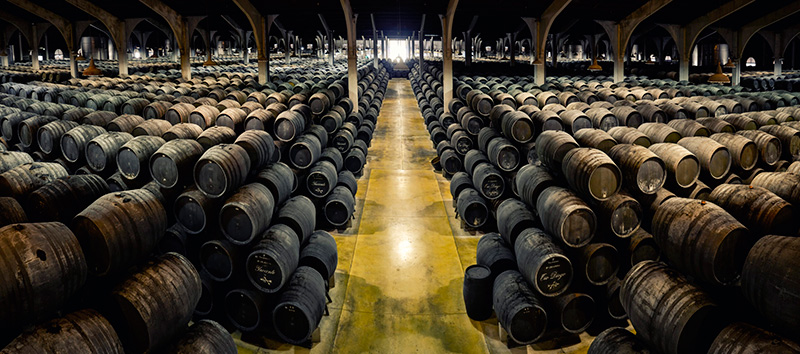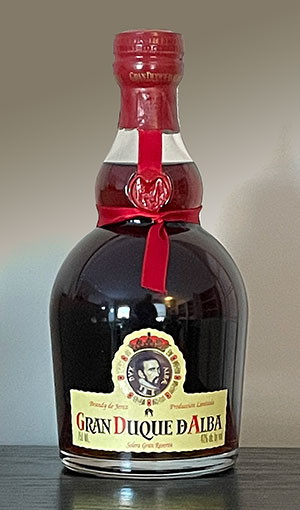For those who don’t know, brandy is distilled from wine and aged in wood to give it its characteristic flavor and color. The word brandy comes from the Dutch brandewijin, meaning “burned (distilled) wine.” It is usually made from grape wine, but can be distilled from other fruit wines, most often apple, in which case it is called apple brandy or applejack generically, and Calvados in France. (Calvados is in northwestern France, on the English Channel.) Cognac, perhaps the best-known type of brandy, specifically comes from the town of Cognac and the delimited surrounding areas in western France. So, all Cognacs are brandy, but not all brandies are Cognac. For more detail on Cognac, click here.
Of course, wherever you find wine you will likely also find brandy, and Spain is no exception. This brandy was first introduced in 1945 by a wine merchant in Madrid at that time. He was a good friend of the Seventh Duke of Alba, Jacobo Fitz-James Stuart y Falcó, and asked the duke if he could endorse the new brandy he was about to offer for sale by applying the duke’s name to it. After tasting it the aristocrat was pleasantly impressed and suggested that for such a noble product it would be far more appropriate to use the name of his ancestor the Great Duke of Alba, Fernando Álvarez de Toledo y Pimentel, who was a Spanish noble, general, and diplomat, shown here. He was an adviser to two Spanish kings, governor of the Duchy of Milan, viceroy of the Kingdom of Naples, governor of the Netherlands, and viceroy and constable of the Kingdom of Portugal.
He is considered by some to be the most effective general of his generation, and perhaps one of the greatest in military history. Although a tough leader, he was respected by his troops, addressing them in his speeches as “gentlemen soldiers” (señores soldados), but he was also popular among them for statements such as, “Kings use men like oranges, first they squeeze the juice and then throw away the peel.” His best-known military exploits were his actions against the revolt of the Netherlands, where he repeatedly defeated the troops of William of Orange and Louis of Nassau during the first stages of the Eighty Years’ War.
All Spanish brandy is produced within the Specific Demarcation of Brandy de Jerez, aka the “Sherry Triangle,” the municipal boundaries of Jerez de la Frontera, El Puerto de Santa María and Sanlúcar de Barrameda, in the province of Cádiz). This brandy begins with the distillation of wine made from Palomino and Airen, two Spanish white grapes that make unremarkable table wines, but are transformed when used for sherry or brandy. The distillation occurs in traditional pot stills at 149º F [65º C], which in Jerez are called alquitara. These are used to obtain spirits of relatively low alcoholic content called holandas, which are made from the best wines for the job. After distillation, the spirits are moved to 500-liter casks of American oak that have previously been used for oloroso (aged and dry) Sherry. These casks constitute a complex and dynamic system known as criaderas and soleras which is exclusive to the region, and is also used in the production of Sherry.

A typical solera.
This system basically involves casks distributed in separate rows, one placed on top of the other, each of which is made up of approximately the same number of casks (known as “butts” in Jerez). The bottom row of casks is named the solera and contains the oldest product, then moving up the rows in order of age comes the first criadara and above this the second criadera and so on. New distillate is added to the top criadera. When brandy is to be bottled it is taken from the bottom solera row – the same quantity taken from each butt and never more than a third of the total content – in an operation known as the saca. The quantity of brandy taken from the solera is then replenished with the same quantity taken from the criadera immediately above, and this in turn with brandy from the next criadera above, and so on. This cascade of liquid is known as the rocio, and it is this continuous blending that enables the brandy to have the same taste, aroma, color, and quality year after year.
Gran Duque d’Alba Solera Gran Reserva Spanish Brandy
This dark amber elixir features a muted nose of leather and prune. The flavors are recessive, even brooding, with hints of sherry, caramel, campfire marshmallow, and just a bit of mineral. On the palate it is smooth and appealing. The profile is quite dry, and has a good long finish. Best used for sipping, rather than mixing. Compares well with Cognacs in the same price range, but with a somewhat mellower profile.
Listen to my podcast about brandy, Cognac, and Armagnac here.
Back to blog posts: https://winervana.com/blog/

